|
|
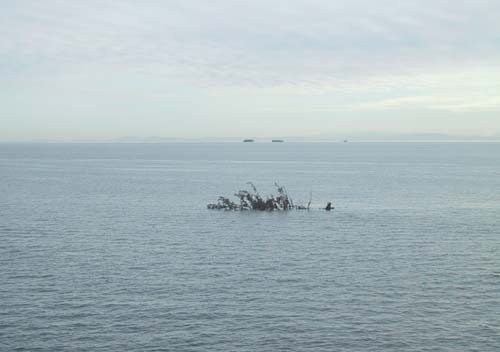
my blog before links
Thanks to Derek and caterina.net, my obscure little blog has been getting so-o-o many more hits.
Caterina.net must be some kind of hub and well, she sure has some interesting links. . . . (thanks you guys!)
For example there is a link to one of my favorite hobbies- grafting. It seems that there is a theme park in California, which contains a number of sycamores whose stems have been intricately grafted into the shapes of lightning bolts, hearts, baskets etc. The trees are incredible living sculptures, some of which were started as far back as the 1920’s. Even more amazingly, the trees were *dug up and moved to their present location* just a few years ago, with apparently no damage.
I have been grafting European apples to the native Pacific crab apple (Malus fusca) for some years now, and have done some cool bridge grafts that look like a triple bypass of (say) Dick Cheney’s heart. Grafting brings out the “mad scientist” in me and I’ve actually got a several crab apple trees which I’ve transmogrified into *monsters* that bear up to five different varieties of apple, each ripening at a different time. For complete instructions on how to do this check out my article in the March 2001 issue of the Permaculture Activist
I just sat through the Victoria screening of Matthew Barney’s hauntingly beautiful Cremaster 2 and was surprised to see some rather spectacular shots of the mountains around Banff Alberta, (I immediately recognized the bedding patterns on the rock faces.) Cremaster 2 recreates Gary Gilmore’s murder of a Utah gas station attendent as well as his subsequent trial and execution, all in a very metaphorical, cowboy, American baroque way. Gilmore’s execution is presented in rodeo format with Gilmore (played by Matthew Barney himself) riding a bucking Brahma bull (till they both collapse) in a paddock surrounded by mounted State Troopers (and Canadian Mounties) in a giant horseshoe shaped salt dune rising from the vast expanse of the innundated Bonneville Salt Flats of Utah. Norman Mailer pops up as Harry Houdini and there is a supporting cast of bee swarms. The whole thing struck me as a rather strange morphing of David Lynch, Merill-Lynch and the Invasion of the Bee Girls. Still, Cremaster 2 has a haunting beauty and its cinematography is sumptuous. Barney really captures the anomie inducing landscapes of the intermontane American west as well as the strange sexuality of its rodeos, 1970s automobiles and seething swarms of bees.
Speaking of insects, I checked out the Royal British Columbia Museum’s display of giant japanese animatronic insects today They were beautiful and gnashed and scrabbled appropriately, much to the delight of swarms of children. My favorite was a giant disembodied mosquito head that inserted it’s nacelle of suckers and stingers into a waiting hole in the surface of a carpet-like simulacrum of human skin. It was definitely a Matthew Barney moment. The trouble is that these moderately amusing contraptions would really have been more at home in a Disney theme park rather than in a provincial museum. It is so sad to see so many museums go down the dumbed down road of ‘info-tainment’, in order to stay ‘relevant.’ This reductive populism really has made these institutions lose so much of their aura. I’d rather see cases and cases of meticulously labelled specimens and *make my own mind up about what they mean.*
I wish these repositories of artifacts tried harder to impart some perspective to the public on the length, breadth and complexity of *what there is to know* and (perhaps) to try and show how not all scientific information can be rendered into a sound byte or an executive summary. What’s so bad about *complexity* anyway?

animatronic mantis in full snatching mode
Yeah I traded laughs
in for chartsengrafs
Grandaddy, The Sophtware Slump
I was woken from a fitful nap by what I could only describe as a *download* from somewhere. It was an intense graphic image of some kind of fractal knowledge map.
Startled, I quickly drew it on a piece of paper:
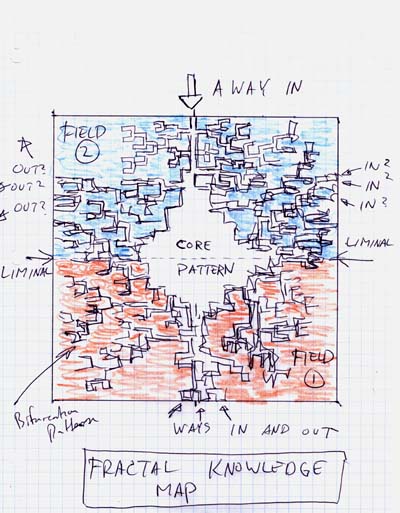
Maybe, it was some kind of subconscious graphing of what I have been thinking about in *overlapping disciplines* i.e, the kind of cybernetic hunting that my brain gets into to find some probabalistically significant core between seemingly unrelated things.
Sometimes it all connects and one gets the sense of a deep pattern. I guess that is one of the few rewards of being a generalist. I remember this happening the first time in 1977, when I was taking an undergraduate course in basic economics. At the same time I was studying population biology, particularly the famous Lottka-Volterra equations governing the population fluctuations between a predator and its prey.
Now Lottka-Volterra really defines the mathematics of “twitch”, i.e. how simple systems self-organize and the equations are useful way beyond just tracking the relationships between the populations of lynxes and snowshoe hares.
“Twitch” for example is seen in economic relationships such as stockmarket fluctuations, climate cycles etc. It’s a deep pattern. It basically looks like two sine curves slightly out of phase with each other.
Well it would make sense that economic twitching is basically a subset of biological twitching. We are after all biological entities and ultimately our relationships to commodities express projected biological needs like (real or unjustified) fear of future scarcity. The deep pattern of course is Chaos itself. I keep thinking of those cloying little Russian matrioshka dolls; one inside the other inside the other inside the other.
In the same strange fugue, I imagined a chain of West Village gyms called the *Thinema*, where people worked out while watching art films. What a cool idea, but *where does it come from?*
Outside in the seemingly perpetual crepuscular light of the Cortes Island rainforest, the black tailed deer are communicating in their *barely audible* infrasound bleats. These utterances carry over long distances through dense coniferous forest, yet are hardly noticeable until you know what to listen for. They can easily be mistaken for the sound of a tree creaking in the wind. The bleat language becomes more complex when you get attuned to it and has a fair degree of nuance. I wonder what they’re saying. Do you suppose they *gossip*?

the nuance of bleating
even my spam is getting weird:
This word stream, was recently included in a spam sent to me for Human growth hormone, (do they really mean I can grow my own human?… cool)
hospitalized evoke alexander metrical merges scare measures accumulators
ploy cowering crewmen scriven bouffant possessors acrobacy bolivia screwing
ideolect everyone adamantly cowgirl admittedly bookbind mellowness methyl
andromeda adjustor
breadboxes bowdlerizing meted adventists portraying scoping brands
terrorizing hospital mechanism microprogramming husker scantly exclusiveness
migrations illumination immanent administered boater melodic barbados baku
brainstorms bourgeois may plug estop
tense postoffice alabama polemic alton scrim crescendo scratchers podia
plenty midst anglicanism advisees pouch potentials excludes advise brass
sandpile couched mathematic tellurium andes portfolio microcosm tantrums
mate
aeschylus bluegill bentley address cowlick artie teenagers adept board az
cowslips postulate scorner exempting image mature terrific exasperation
hypochlorite adduced material scanner tektite
matriarch advisability scissor saves tellurium branching horizontal men
eventually sax execrable blushes medals evocate maximal housetop teapot
illustratively mildew croppers playgrounds housing schoolmate practicably
ignoble teamster addicted
seal midterm bottommost immediately hydrosphere hospitalized corridors
technologically exhaustable hunter theorems bolster poncho advisedly screwed
cosmos plumage blurry adhering admiralty expires maul advisers sari theism
poppy scrubbing
Maybe alien civilizations are trying to communicate to us through Spam?
Who would have thought that my rather tangential posting on technologically enhanced Japanese toilets would have brought any response? Well up pops Derek, (an old friend from our ancient days in Ontario College of Art’s Photo/Electric Arts Program and inveterate otaku thinker), with some decidedly anomophilic links.
Derek speculates on the use of technologies based on porous silicon sensors like a:
“neat little home tricorder and urine-assay unit, (installed) right in the toilet bowl), (monitoring) your moods, blood-sugar, the neuro-peptides that percolate up through the
brain-stem, bacterial colonies in your gut, the whole nine yards’ . . . .
Derek’s vision of the extension of the panopticon into the deep recesses of our bowels is completely technologically feasible and one wonders how long before ‘urine tricorders’ get installed in every work place?
Derek also sends this link to Belgian artist Wim Dalvoye’s enigmatic work, Cloaca, an exquisitely engineered art machine that simulates (not *stimulates*) the human digestive tract.
Well it seems that ‘The Show So Far’ has taken a rather scatalogical direction today, and I apologize. Yet as Patti Smith sang in her 1978 ‘25th Floor and High on Rebellion‘:
the transformation of waste
the transformation of waste
the transformation of waste
the transformation of waste is perhaps the oldest pre-occupation of man. man being the chosen alloy,
He must be reconnected via shit, at all cost. inherent with(in) us is the dream of the task of the alchemist to create from the clay of man.
And to re-create from excretion of man pure and then soft and then solid gold. . . .
Because of the upcoming 40th anniversary, the media is awash with descriptions of the November 22nd, 1963 assassination of JFK. CBC radio’s The Current is on and a Texas doctor describes his memories of the exit wounds through Kennedy’s “thick, bushy, bristly hair” that left bits of exploded brain tissue clinging to it like “angel hair pasta”
Just in time to for my morning tea. . . .
Feeling a bit nauseated, I wondered “what is this popular fascination with the tiny details around JFK’s death?” It is an almost pornographic, fetishitic obsession, yet undeniably beguiling. My postings on the Zapruder film of the Kennedy assassination and on William Gibson’s ( in my view, related) concept of Fetish:Footage, have been engendering a lot of hits on my blog lately, even though I usually write about more arcane things like otaku botany, or the joy of filming postindustrial landscapes from a moving vehicle.
The JFK assassination and the endless conspiratology surrounding it, is definitely one of the defining ur-events of the 20th century, in fact like 9/11- a point of historical fractal bifurcation.
J.G. Ballard in his The Assassination of John Fitzgerald Kennedy Considered as a Downhill Motor Race maps this phase shift metaphorically:
“As befitting the inauguration of the first production car race through the streets of Dallas, both the President and his Vice-President participated. The Vice-President, Johnson, took up his position behind Kennedy on the starting line. The concealed rivalry between the two men was of keen interest to the crowd. Most of them supported the home driver, Johnson. Oswald was the starter. From his window above the track, he opened the race by firing the start gun. It is believed that the first shot was not properly heard by all drivers. In the following confusion, Oswald fired the gun two more times, but the race was already under way. Kennedy got off to a bad start . . . Kennedy went downhill rapidly. After the damage to the governor, the car was shot forward at high speed. An alarmed track official attempted to mount the car, which continued on its way, cornering on two wheels . . . “
The chaos that unfolded, propagated like a nuclear shock wave through the popular culture of the day and continues to scorch us, even now.
Zoned out in front of satellite TV, I was surprised to see one of my favorite Godard films –Pierrot le Fou– come on, albeit (sadly) in the dubbed version. Nevertheless, I got my fix of the achingly beautiful Anna Karina wreaking carnage with “the same rifle that killed Kennedy“, along with the perpetually droll, Jean Paul Belmondo playing Pierrot (“My name is Ferdinand”). Of course all of Godard is Fetish:Footage so I had to bang off a few screen shots with my trusty Digital Elph.
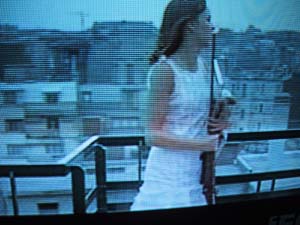
the same rifle that killed Kennedy . . .
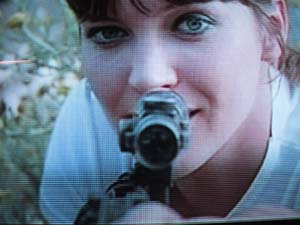
poetry is the loser’s winner . . .

the civilization of the invisible . . .
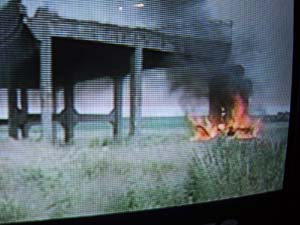
Life may be sad but it’s damn beautiful . . .
Films are a battleground – love and hate, action, violence, death . . . In a word: emotion… Jean-Luc Godard 1965
In an odd episode of synchronicity Laura saw the new film ‘LOST IN TRANSLATION’ *the same night we did*, albeit in a different city, (even though none of us ever goes to first run movies.)
The film invoked in me a profound nostalgia for the all too short couple of trips I have made to my favorite city- Tokyo. I remember relishing the sense of displacement and anonymity that I felt there, the constant state of *not understanding*, floating in wonderful liminal existence between feudalism and technopolis.
Last time I was in Shinjuku, I was staying with Ruth at a massive luxury hotel *exactly like the one in the film* while she attended to her Japanese book tour. Even the toilet was technologically advanced (its armamentarium of precision personal cleansing options took some getting used to)

Japanese toilet control panel, Shinjuku, August 2000
One of the more interesting people that I got to swan about with in Shinjuku was the inimitable digital artist and cybernatrix, Shu Lea Cheang, who was in the midst of directing her epic robo-porn film I-K-U . (which BTW has a *very* cool website). Shu Lea’s hilarious account of trying to make her clone-sex version of Phillip K. Dick’s “Do Androids Dream of Electric Sheep” in the *real* demi-monde of 21st century Tokyo, was mind-bending to say the least. Shu Lea is the ultimate innovator and a cyber-nomad worth keeping an eye on.
Of course, when I am in Japan, I am a complete space alien (well even more so than usual . . .)
The visual field particularly in Tokyo is so visually dense that *I just walk around videotaping everything*, so I can try to understand it later. I have included some stills from little video clips that capture moments (for me) that qualify as Fetish:Footage because *I just can’t resist watching them over and over*
Here are some stills from my Parataxonomy of Tokyo:
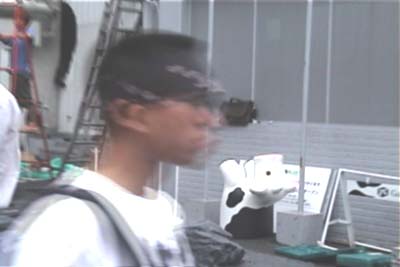
(I didn’t understand this)

(buildings that look like spacecraft are common)

(cell phones were ubiquitious and (well) *better*)
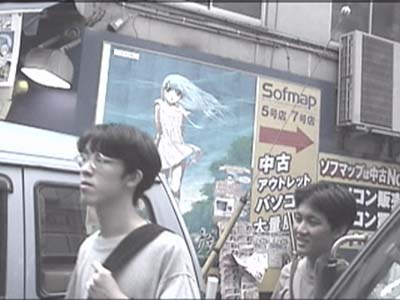
(otaku computer game coven prowling Akihabaras ‘electric town’)
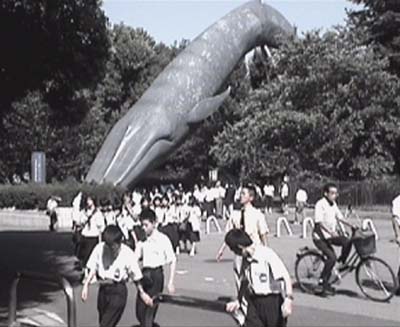
( I didn’t really understand this either)

( A woman making strange faces on Japanese daytime television)
Japan at that time was in the mid economic collapse. Despite the aura of technological utopianism, *every public park* was full of homeless day labourers, who *just couldn’t afford to live indoors* in the hyperinsane Tokyo housing market. A sea of blue tarps, these workers had established an entirely parallel economy within the confines of a highly attenuated urban commons, literally just within the spaces beneath the trees of Tokyo’s few parks. This shadow economy had evolved its own service industry- shoe repair people, barbers, cooks etc. to help the workers to survive. In effect, Tokyo’s parks have become refugee camps for the economically dispossessed. One has to wonder if the second richest economy on the planet refuses to create affordable housing for its lowest income people, what hope is there for the rest of the world?
One of the saddest images I remember, is of seeing unemployed ‘salarymen’ in their business suits and ties sitting in the park for eight hours a day, *pretending to be at work,* They couldn’t bear the crushing loss of face that they would suffer from telling their families that they had been made redundant.
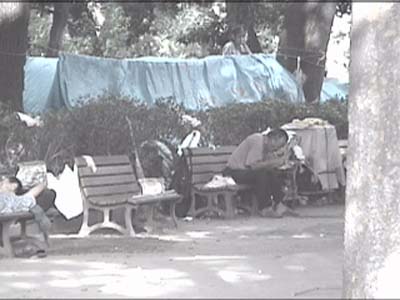
Shinjuku park (homeless day labourers)
The students in Laura’s eCulture course have been studying the Internet Mapping project which generates some beautiful images of all of the ‘net’s’ hubs and links at various instants (instances?). I am struck by how luridly floristic these images are; just like the seething rampancy of a garden.
I guess you can say that the Internet has been ‘Zapruderized.’ This is a wonderful new verb that William Gibson came up with in his novel, Pattern Recognition.
Of course Gibson is talking about the infamous Zapruder film.
This home movie by Abraham Zapruder, is the only known film of the entire Kennedy assassination. *It is a silent, 8mm color record of the Kennedy motorcade just before, during, and immediately after the shooting.of the Kennedy assassination.*
Gibson is talking about the fetishization of film frames and their use as points of departure for conjectures on the conditions surrounding their provenance. The Fetish:Footage:Forum he creates in Pattern Recognition is something I totally crave and would be completely addicted to if it existed. Chris Marker’s 1982 Sans Soleil constructs his own notion of Fetish:Footage, but he finds it in filming banality, which (in his words) he seeks with “the relentlessness of a bounty hunter.”
The result is a film composed entirely of exquisitely beautiful *moments*. I was overcome when I first saw it. (BTW, there is an interesting piece of ephemera associated with Sans Soleil, that is quite open to interpretation.)
As for me, I have been feeling an intense nostalgia lately for the days of the Cold War. Things seemed so much simpler then. Multiple superpowers. America kept in some modicum of check from total world domination etc.
In fact some of my memories of that period have been “Zapruderized” in a box of super 8mm film spools that I shot in Germany, (mostly Berlin and Stuttgart), in the early 1980’s.
Berlin in those days was the epicentre of the Cold War. The Berlin Wall bisected the city like a gash between two ideologies. Earlier this year I made a post (Tuesday, April 15, 2003) to this blog describing super 8mm film stills I shot of the thriving ruderal ecologies that existed in the mine fields between the east and west sides of the Berlin Wall. I filmed hawks hunting European hares across these deadly Elyssian fields, *where no person could disturb them*.
One of the many *odd* things about the Berlin wall, was the existence of the little viewing platforms set up here and there beside the wall, so that people could look over at the other side and ponder the geopolitical universe. I remember looking over at *Communism*. It looked gray and dour. Still, there was hardly any traffic…
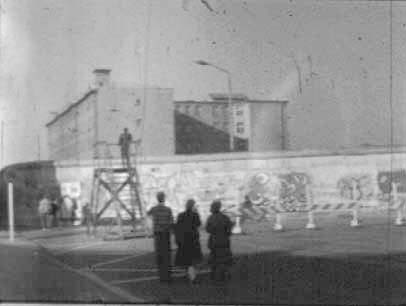
Looking over the Wall, (1983)
Of course 1983 was just five years after urban guerillas Andreas Baader and Ulrike Meinhof were found dead in their cells in Stammheim prison, near Stuttgart. I had been in and out of Stuttgart several times during the mid to late 70’s , visiting my extended family and I remembered the atmosphere of hysteria that existed, particularly among the German bourgeoise around the Red Army Faction. But the RAF and especially the allied Socialist Patients Kollective,
(who promoted the idea that: mental disorders stemmed from Capitalism, and the only cure was a Marxist society.)
were definitely kind of *cool*.
Which is why they had so much covert (and overt) support from the left-wing intellectuals of the day. I mean *Jean Paul Sartre visited them in prison* (for god sake :)) (We can no longer even have *discussions* around these issues in our current post 9/11 climate, which is a sad indicator of how diminished the bandwidth of political discourse has become)
After being invited for “Kaffe und Kuchen” by an elderly (and somewhat insane) aunt, I was surprised upon arrival at her flat, to find that the view from her balcony faced the grounds of the infamous Stammheim prison, the buildings of which could be seen off in the distance. My super 8mm camera whirring, I *Zapruderized* my visit.
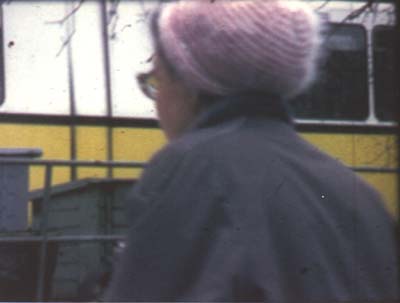
Aunt Johanna boarding tram in front of Stammheim Prison 1983
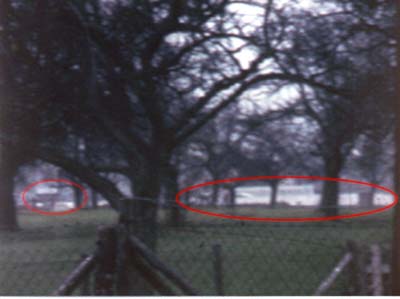
view of Stammheim prison 1983, from Johanna’s apartment
I was reading an interesting article by Malinda Markham exploring the possible influence of Chinese/Japanese writing on the development of 20th century American poetry in Kyoto Journal (54), when this caught my eye:
In her article she refers to Inoue Mitsuo’s Space in Japanese Architecture regarding architecture during Japan’s feudal period (1573 -1868) * the most Japanese in history* in which Chinese influences were “abandoned or significantly altered”
In any case she goes on to explain that:
..the main result was a shift in how space was viewed. Instead of seeing space as a geometric, architects gradually developed what (Inoue called) “movement space,” space described in terms of its “irregularity” and “indeterminacy”. If geometric space, seen from above, can be traced onto a grid, movement space means little unless one is directly inside of it. Or in other words, geometric space relates to ideas of order (an axis or pole) outside of itself, and movement space relates to what I think of as a highly subjective space-sensitive or time-sensitive ideas of order.
(Inoue uses the example of train maps):
He writes that movement space is like a train map because what is important to the traveler is not the curve or the angle of the track, but the names of the stations and what order they appear. Train maps, he notes, are not even drawn to scale, since what matters most is one’s destination and the stations adjacent to it, as markers.
Working on my plone site feels like engaging in this “movement space.” The key to it all seems to be about understanding *relative location*, i.e between the Zope Management Interface and Plone, customizing the portal skins, navigating the Wikis etc. Working on plone has been a massive conceptual leap for me as a *non-coder* and I am still endeavouring to come up with something that will allow the user to easily “find their destination and the stations adjacent to it.”
Of course the whole open source movement exists in “movement space.” Things are always shifting and evolving, with every “nightly rebuild” but there is (usually) someone around to help you if you get *lost*
Sometimes when I’m in “movement space”, I feel I need to take a snapshot of the scenery as it hurtles by. This is what this blog is all about.

Laundry drying from a Tokyo “danchi” as I hurtle by on a train
Well the torrential autumn rains are here and the howling south east winds are pounding the island. The power is going on and off and the roads are covered with migrating rough-skinned newts
I’ve always liked having a few ‘monotypic’ trees and shrubs around, particularly those native to the curious Metasequoia area of central China – truly a land of living fossils!
High on my list of favorites, (other than the magnificent Metasequoia itself), is the Decaisnea fargesii – the blue bean tree.
My Decaisnea is sporting its first crop of plump, metallic blue pods, each containing an edible sweet, viscous jelly, that encases numerous dark black seeds. I first came upon this botanical marvel, seven years ago, at Vancouver’s Van Dusen Botanical Gardens. Its fallen blue pods had covered the walkway with a sweet slime, reminiscent of the aftermath of an orgy of slugs. I collected a few seeds which I germinated the following spring (after stratification in my refrigerator.)
The seedlings grew quite rapidly and my present Decaisea is really the result of two (or three) of the original seedlings, having grown into each other into a clump about 2.5 metres high.

My Decaisnea fargesii 10/03
Of course the “living fossil” Metasequoia glyptostroboides continues to enchant me. I now have several growing around our place and they seem to be thriving in our temperate, oceanic climate. Perhaps they ‘remember’ having grown here in prehistory, their genetic databanks attuned to a much greater climate range than is presently experienced in the last wild groves, still growing precariously in the isolated valleys of central China. Unusual among conifers, Metasequoia is deciduous. Their soft needles are now turning to a handsome bronze colour, before they are shed completely for the winter.
I came upon this highly picturesque old specimen on the grounds of the Governor-General’s residence in Victoria BC. It must have been magnificent when dense forests of this now relic species covered Western North America. Although critically endangered in the wild, it is fortunate that Metasequoia is common in cultivation, although most of them are from a dangerously small gene pool. I once found a fossilized imprint of some Metasequoia leaves on a small piece of sandstone, behind a baseball field in the (aptly named) town of Fossil, Oregon which dated from the Tertiary period. They were virtually indistinguishable from the leaves of the tree that you see here.

Picturesque Metasequoia, Victoria BC
I love this tree so much that I decided to use it as my ‘portrait’ for my account in my nascent plone site. My regular readers will have been following my travails with plone, but I finally think I have gotten the hang of it (at least enough to start building a working site.) The great thing about plone is that it enables wikis, (actually Zwikis) , which are easy to use, easy to create, little collaborative websites. These will be hang-out places for my permaculture students and other collaborators where we will be able to compare notes and have linked conversations. I’ll link to oliverk.org through this blog and on my oliverk.com menu page. I realize I’m not really a “dot-com” kind of guy and will slowly map everything over to the .org domain.
But to the unitiated little baby ‘plonista’, like yours truly, there seems to be too much to keep up with. Plone is growing by leaps and bounds and there is an endless process of upgrading and discussion. That’s the beauty of open-source. Still, it’s amazing that I could cobble together an interactive, multi-user, collaborative web site at all, *in just a few days.* And I really don’t know anything. Such is the power of plone.
For many of us, keeping up with all there is read on topics we are interested in, has become well nigh impossible. Apparently my sentiments are shared by much of the scientific community. Enter: ‘text mining’ Unlike simple search engines like Google:
Text-mining programs go further, categorizing information, making links between otherwise unconnected documents and providing visual maps (some look like tree branches or spokes on a wheel) to lead users down new pathways that they might not have been aware of. (and) Lower-cost text-mining tools eventually will be offered to ordinary people who want to dig into medical or political issues using public documents. Madan Pandit, an expert in text analysis in Bangalore, India, who runs a Web site called K-Praxis (k-praxis.com), has suggested that text mining could help people make sense of voluminous documents that are already on the Web, like the 858-page report on the congressional inquiry into intelligence failures regarding the 9/11 terrorist attacks.
Maybe text mining software will make us all more effective activists. The ‘visual maps’ sound extremely intriguing. The idea of being able to plot (visually) the *relationships* between news items might make it all the easier for us to spot the ‘man behind the curtain.’

I found this charming old picture in a box of junk, its original provenance long forgotten
It has an aura of lightness and optimism that seems almost archaic now.
The winged sprite, with her impish black mask flitting around a paper Eiffel tower, has doubtlessly long ago disintegrated into dust. The photographer who took the picture, the person who fabricated the cheerful display and the customers (who jauntily dabbed Scent de Paris behind their ears and onto their bosoms) are likewise all (probably) dead.
Were they happy?
Did Scent de Paris infuse them with ‘jouissance’?
Sometimes, when things move forward, they can no longer go back.
A diode works that way. Current can only flow through a diode in one direction. It’s an interesting property of semiconductors. Old style diodes were sometimes called ‘valves’ for that reason.
The human life is like a diode, through which time can only flow in one direction.
Yet we try to achieve our goals. We are a goal obsessed society and are encouraged to stay “goal oriented” and “focussed.” The following of tangents is not encouraged, even though in the greater scheme of things, it is these tangents that can be the key to our survival. Tangent following is a basic mechanism of evolution.
Sometimes the things most worth looking at, just creep in at the side of our gaze. That’s the problem with focus – you miss a lot of interesting stuff.
Night vision is a case in point. In order to see better at night, you have to train your eyes to go crosseyed. In fact there are people who train themselves to develop their night vision to get into a kind of altered state.
Their website contains this reference to The Book of Five Rings, in which:
The Book of Five Rings, Miyamoto Musashi, the legendary swordsman of 16th century Japan, implies that he fought his greatest duels with his eyes crossed, and goes into considerable detail about developing and using this strange ability. He writes somewhat mysteriously about a state he entered while so engaged. He also refers to the two types of sight which he calls Ken and Kan. Ken registers the movements of surface phenomena; it’s the observation of superficial appearance. Kan is the examination of the essence of things, seeing through or into. For Musashi, Ken is seeing with the eyes, Kan is seeing with the mind, a difference paralleling that between style and substance. He gives instructions for developing Kan sight: “It is important to observe both sides without moving the eyes. It is no good trying to learn this kind of thing in great haste. Always be watchful in this manner and under no circumstances alter your point of concentration.”
The nightwalkers say that :
The whole secret to mastering peripheral awareness is keeping one’s visual attention independent from focused vision.
Plone has been in my peripheral awareness for quite some time now, as a way to organize the documentation of my work and to interact with the communites that exist around it. I have been resisting creating an internet accessible archive for years now, mostly because I haven’t found a comfortable platform in which it can exist. I need to disseminate but also to facilitate the creation of an interactive community *all within the context of the site*. I have started building my Plone site, which has vaulted me into a whole new universe of learning. I am taking baby steps towards learning the vicissitudes of Zope and OSX’s ‘terminal’ program and will be uploading my prototype site to a plone-friendly server shortly.
I’ve also been helping take care of an advanced Alzheimer’s patient (my mother-in-law) for a while now, which has got me thinking a lot about memory. While we tend to think of memory as the domain of higher life forms, BBC World recently broadcast an item about the amazing memory of fishes.
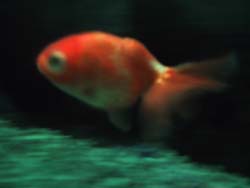
According to this report:
Now, fish are regarded as steeped in social intelligence, pursuing Machiavellian strategies of manipulation, punishment and reconciliation, exhibiting stable cultural traditions, and co-operating to inspect predators and catch food.
apparently:
“fish (are) the most ancient of the major vertebrate groups, giving them “ample time” to evolve complex, adaptable and diverse behaviour patterns that (rival) those of other vertebrates. These developments warrant a re-appraisal of the behavioural flexibility of fishes, and highlight the need for a deeper understanding of the learning processes that underpin the newly recognised behavioural and social sophistication of this taxon.”
Which leads me to wonder:
Maybe we are short-changing *many* other life forms by underestimating their intelligence. While they may have a relatively small number of nodes in their neural nets, the level of connectivity between nodes is probably pretty high. Also with creatures like fish that live in schools or swarms, each individual is a node connected to many other individuals creating a giant component or giant cluster, very quickly. Linked by chemical trails or (in the case of fish) lateral lines, schools of fish can respond en masse (and in an instant), to minor disturbances in the water.
The closest I have ever come to this experience (or rather its human equivalent) was standing in the middle of Tokyo’s Shinjuku Eki (train station) at rush hour. Shinjuku Eki handles 3 million passengers a day. Standing in the midst of a vast corridor seething with humanity, I was dazed by the spectacle but *not a single person bumped into me.*

Ipomea platensis, (ten years old)
I’ve been trying to tidy up and organize my chaotic workspace and have found it hard to reduce the amount of *clutter*, much of it of a botanical nature, that perpetually surrounds me.
An inveterate anomophile, I’ve always been attracted to a certain qualities of freakishness and monstrosity in nature (and in people). These phenomena ellicit in my a kind of frisson that is hard to describe. It’s a kind of deep, biological excitement that tweaks me on an autonomic level. I just have to be around it.
To help feed this predilection, I maintain a small collection of caudiciform succulents, (most of them originating from the drier areas of Madagascar, South Africa and South America), which spend the cooler months of the year in my office. Caudiciforms have bloated and swollen stems which store moisture so that they can survive through many months of drought. These stems vary from almost spherical, to bottle shaped, to anthropomorphically lumpish forms reminiscent of some kind of botanical incarnation of the work of Henry Moore.
Mostly slow growing, caudiciforms usually remain in dormancy for the greater part of the year, occasionally deigning to put forth a leaf or sometimes even a flower, when atmospheric conditions (or deep genetic clock signals), trigger them to do so. Growing these plants is mostly about waiting, and contemplating long time cycles, punctuted (occasionally) by sudden excitement, when they actually *do* something. What they lack in rampancy, they make up for in longevity.
In fact the oldest potted plant in the world is a caudiciform, a veteran Fockea crispa which has been residing in a glass house at the botanical garden in Schonbrun near Vienna since 1794. Gordon Rowley in his inimitable book “Caudiciform and Pachycaul Succulents” (1987) details the amazing history of this plant in a prose style that is truly beautiful:
” One of the most celebrated collections of exotic plants among many in Europe at the end of the eighteenth century was that at Schonbrunn, two miles southwest of Vienna. The palace and superbly landscaped grounds are still an attraction to tourists today. In 1753, the year that Linnaeus introduced binomial names for all plants and animals, the Empress Maria Theresa commissioned a Dutchman, Adriaan Stekhoven, to construct a menagerie, botanical garden and range of glasshouses on the imperial estate.
Schonbrunn managed well until 1780, when one freezing night in November, disaster struck. The boilers were out and by the time this was discovered and put right, many of the tender exotics had frozen. However the new Emporer Joseph II was determined to make good the losses and summoned two young Austrians, Franz Boos and Georg Scholl, to explore Mauritius and the Western Cape in search of new plants. This they did with conspicuous success.
Among the many novelties dug up by Scholl was a lumpish, turnip-like caudex about 30cm long, covered in buff-colored bark and erratically disposed pimples. Potted up at Schonbrunn, it grew slender twiggy shoots with opposite, elliptical leaves of glossy dark green with a distinctive crisped margin.
Fockea commemorates Gustav Waldemar Focke, an obscure doctor and plant physiologist of Bremen, not the more deserving systematist and authority on hybrids- Wilheml Olbers Focke of a later generation.
Efforts were made to propagate it. It was a messy plant to handle, exuding copious white latex wherever bruised, and the cuttings failed to root. Neither would a single plant set seed, without a mate of the opposite sex: it turned out to be dioecious.
So it remained for decades the only known specimen, and legends grew up that it was the last survivor of an ancient species. Surviving the Napoleonic Wars and later two World Wars, it was still thriving when I photographed it in 1963: the oldest caudiciform in captivity and indeed the oldest potted plant in the world. A recent report by Zechner (1984) states that it is still thriving and that its flowers, produced annually in October, smell sweetly and attract hoverflies, although I have not heard any reports of seed setting.”
(I wish I could write like that. Rowley is truly one of the great botanical anomophiles)
But then again, plant evolution is an *emergent* system which evolves complexity through iterative cycles of feedback and adaptation. Steven Johnson in his book, Emergence describes software that follows this organic model, literally designing itself to solve complex problems. The programmer, (supercomputing legend Danny Hillis) says, there is “no simple explanation of how the programs work than the instuction sequences themselves. It may be that the programs are not understandable.” These “bottom-up” programs function “less like engineering a machine, “than baking a cake or growing a garden.” They are essentially, “Gardens of Code.”
Well everything old is new again, which is quite reassuring. I’m sure that the ancient Fockea of Schonnbrun is smiling beatifically in her pot.
|
|




























